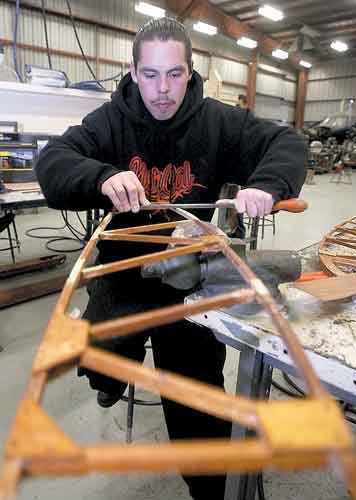Area high schools are providing students who are not on the
college track with a variety of interesting options, and local
businesses have a pool of skilled and semi-skilled workers enrolled
in vocational programs and Regional Occupational Programs. All this
despite the national, state and local focus on academics and
testing under the
”
No Child Left Behind
”
act, which some think leaves little room for giving students an
opportunity to choose from a variety of electives or more
trade-oriented courses.
Area high schools are providing students who are not on the college track with a variety of interesting options, and local businesses have a pool of skilled and semi-skilled workers enrolled in vocational programs and Regional Occupational Programs. All this despite the national, state and local focus on academics and testing under the “No Child Left Behind” act, which some think leaves little room for giving students an opportunity to choose from a variety of electives or more trade-oriented courses.
June Kadoyama, ROP specialist for the Morgan Hill Unified School District, said despite the belief that a student has to choose between a vocational and academic career, there are many opportunities available that combine the two.
“All the career and technical education courses are aligned with state standards, the ROP courses do teach to standards,” she said. “English, math, social science are worked into the curriculum. There is math in everything from fashion design to carpentry, that’s how the curriculum was developed.”
Local businesses play an important role in the ROP program and vocational education, she said.
“For every course, we have an advisory committee, we pull in some relevant businesses so we can keep a pulse on the need for skilled workers,” she said. “At the end of the year, the students who complete the course are actually given a certificate of completion, and on the back of the certificate, there is a list of the specific skills the student has mastered, what level the student has attained. Certificates from these courses constitutes a good part of the students resume portfolio. A lot of these courses lead to internships or articulate into West Valley College or Gavilan College.”
Wastewater Solutions in Hollister is a small family corporation that is growing. One of the corporation’s principals, Gwen Miller, said her son went through a vocational program.
“We are huge supporters of vocational education,” she said. “Every kid is different in what they need. I know that the schools here have excellent programs … and as soon as we grow to a certain size, we’d love to hire students that have been through the program.”
One of the challenges the vocational programs face is keeping up with changes in technology, though much of what is offered locally is up to date.
Larry Kwong, owner of The Printing Spot in Gilroy, says his industry particularly is faced with the challenge of keeping current.
“Nowadays, technology is moving so fast they’re having problems keeping up,” he said. “But I have always liked to hire kids from the programs at schools. I can think of several that have gone on to be very successful. I think there are lots of opportunities for those kids, lots of choices. We had one student that stayed with us and moved on up to be a salesman later. We buy our paper from him. There was another girl we hired from the program, and she became a manager. She was exceptional. I took a trip to China, and she managed the business for me while I was gone.”
Karen Tarp, who with husband, Jim, owns Jet Electric in Morgan Hill, said most of the apprentices they hire start with no experience and work under a journeyman to learn the trade. Although she wishes there were more trade school opportunities for high school graduates, she also says Jim would rather hire workers straight out of school than someone who has worked from someone else.
“Sometimes when they’re a bit older and have worked for other people for a while before coming to us, they can bring bad habits with them,” she said. “Jim likes to train them to do things his way from the beginning.”
She said she believes that nationwide, there is not enough emphasis on providing opportunities for learning a trade. “Not every high school student wants to go on to college,” she said. “If you know you want to be a plumber or an electrician, why not go directly to learn your trade? In Europe, there are more opportunities, more trade schools. Here, we’re more fixated on sending every child to college.”














